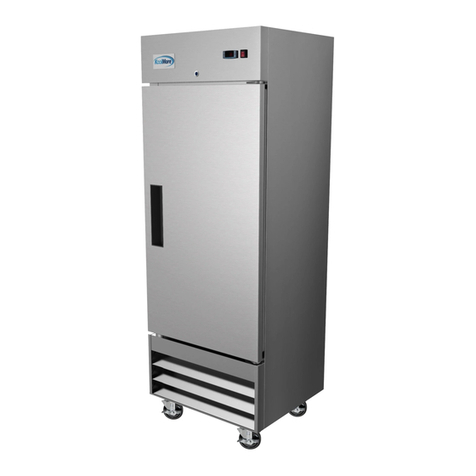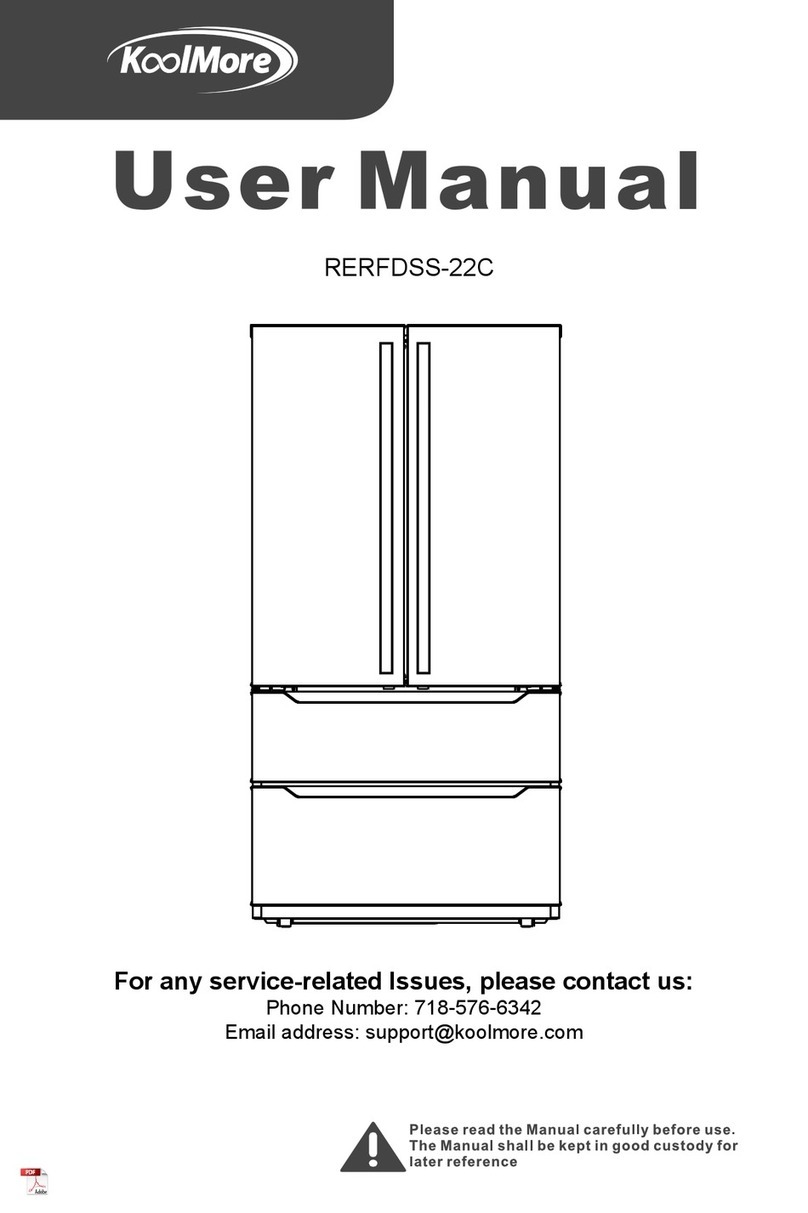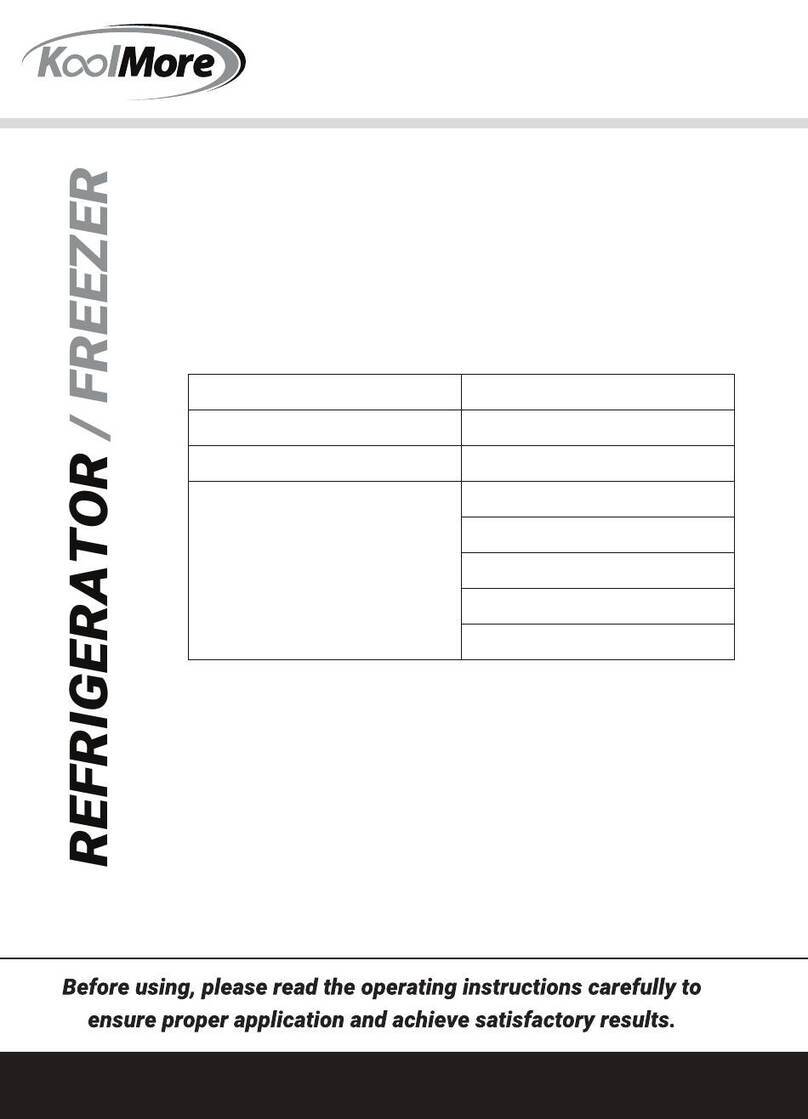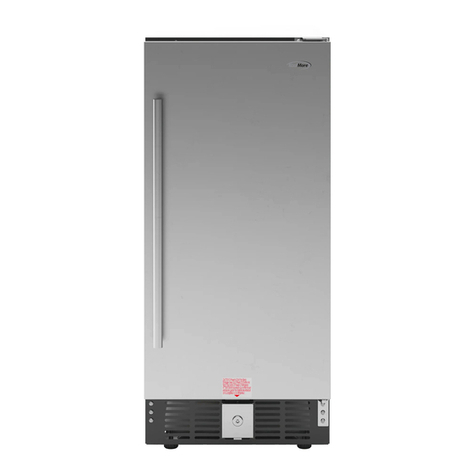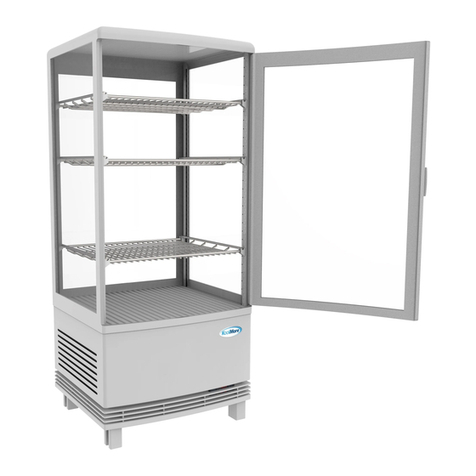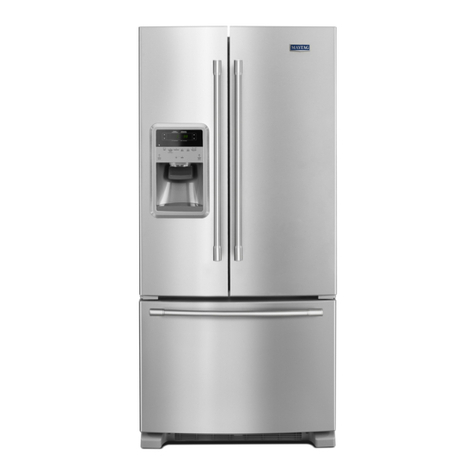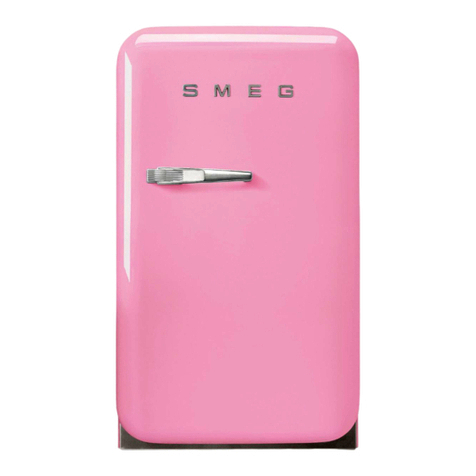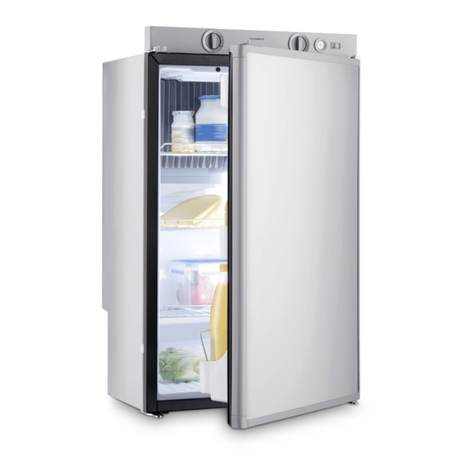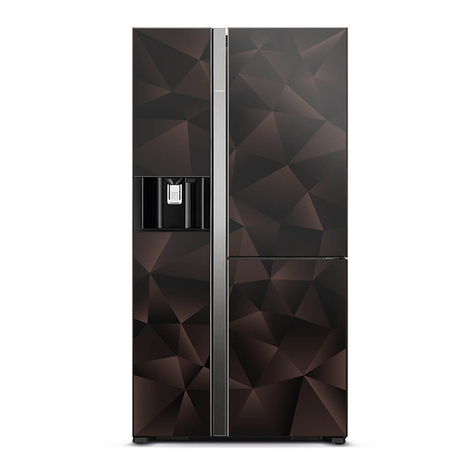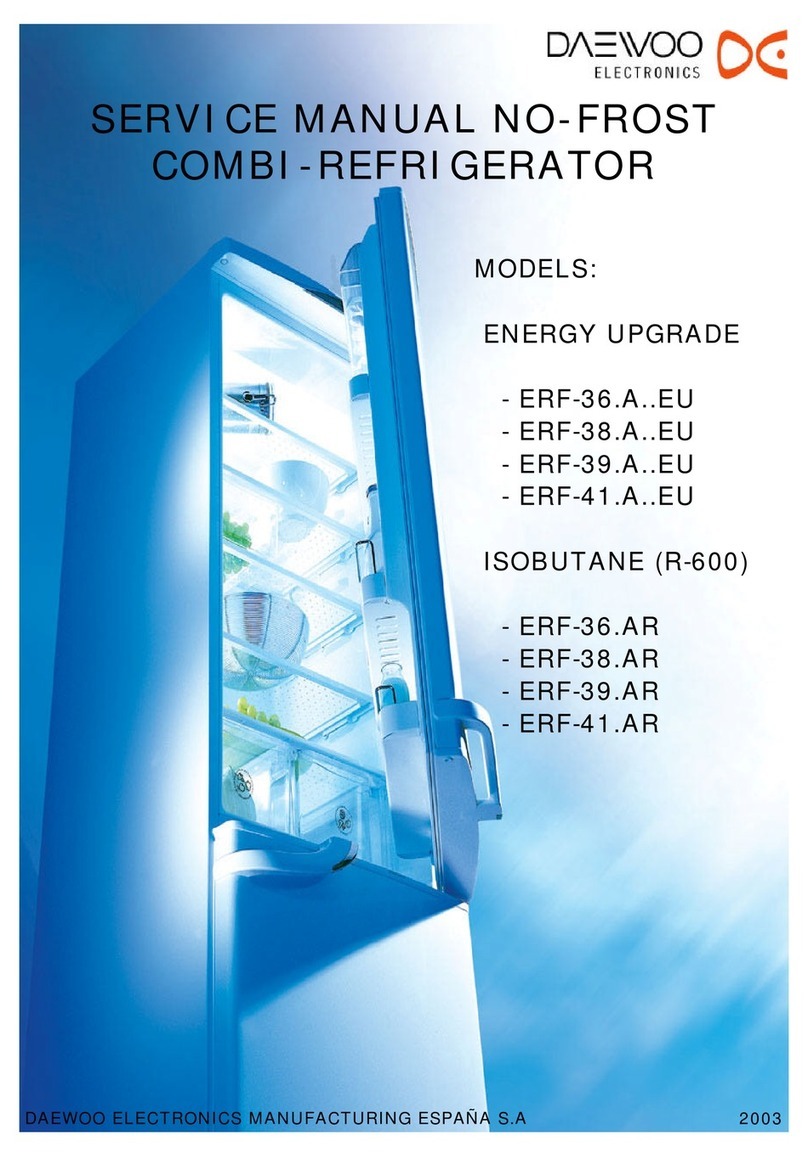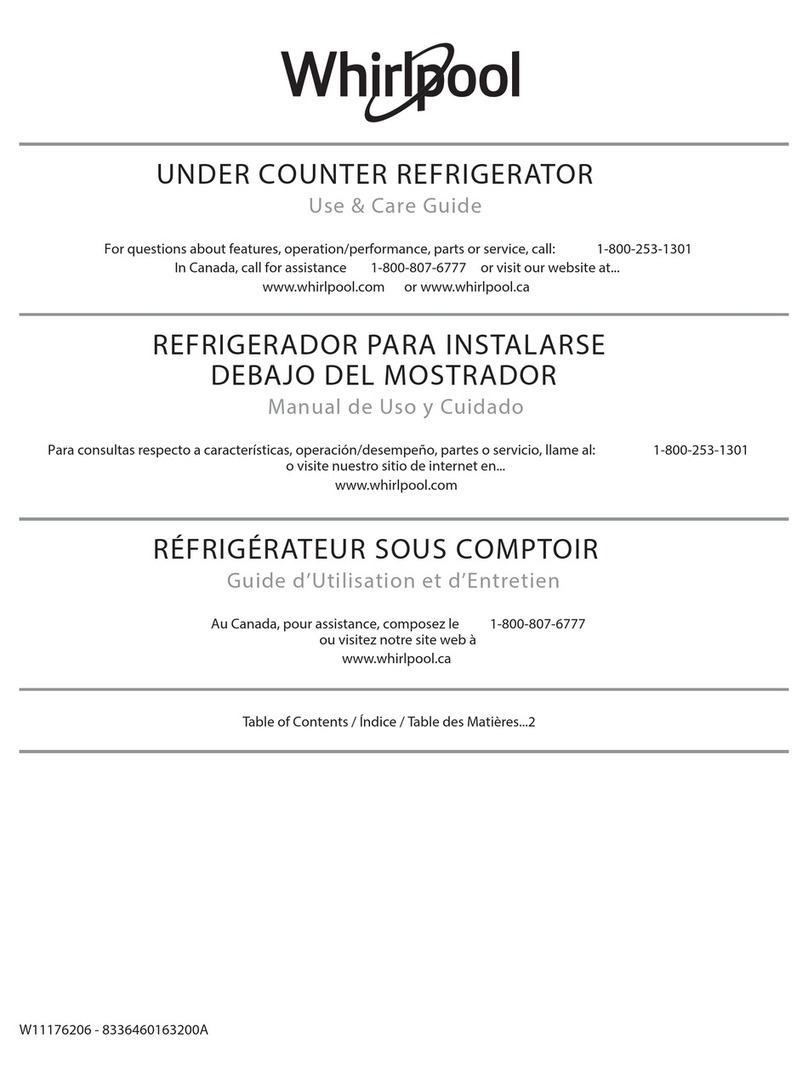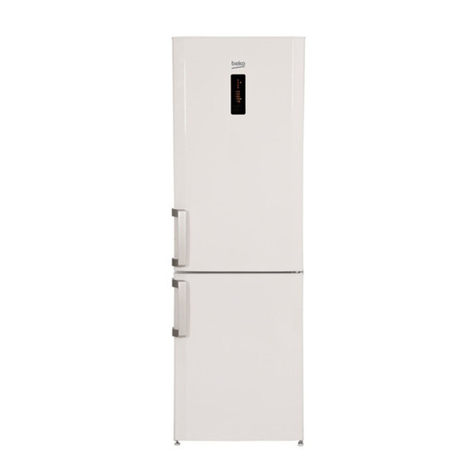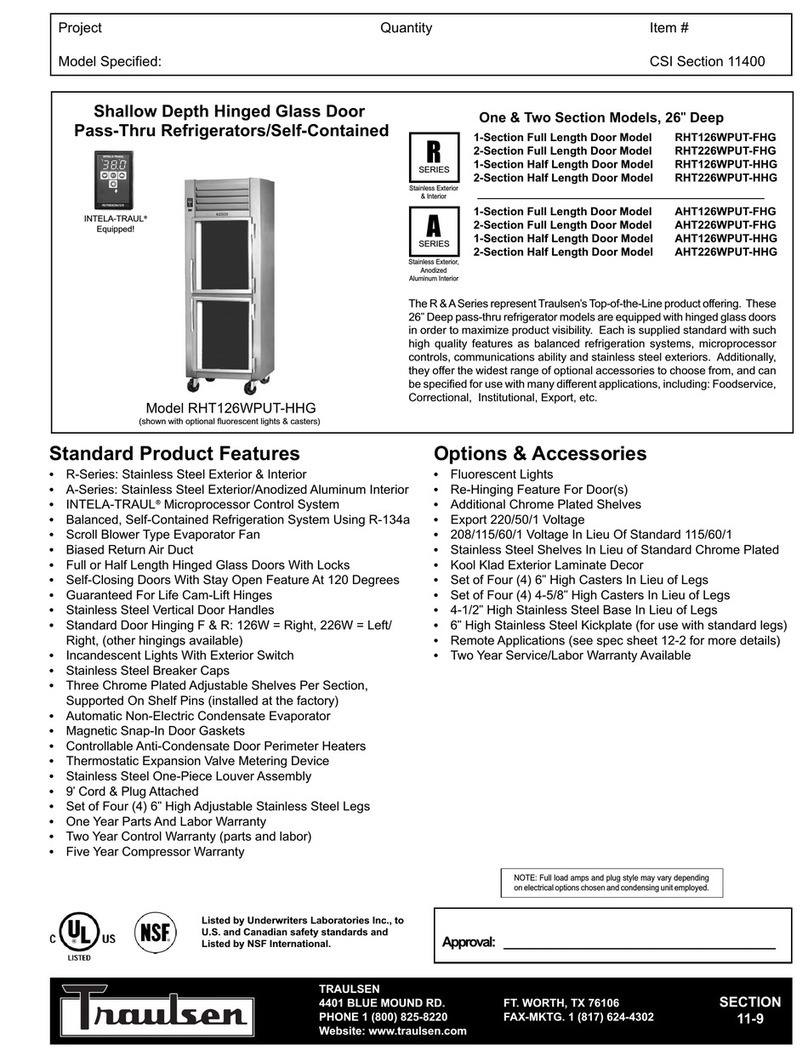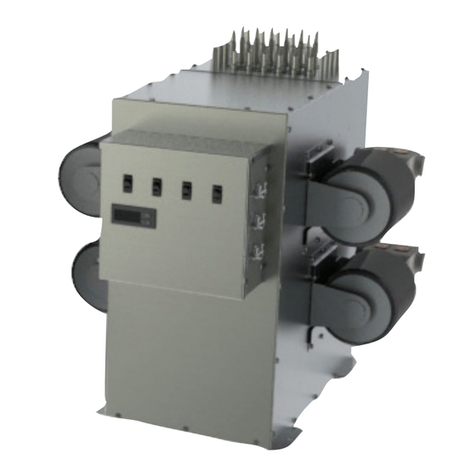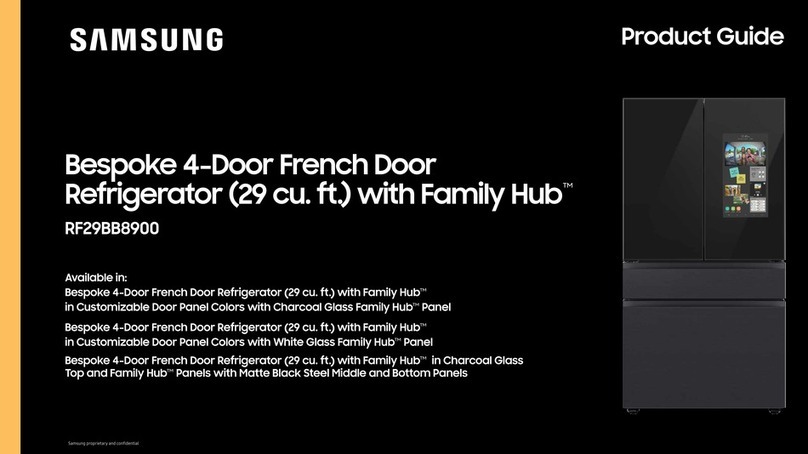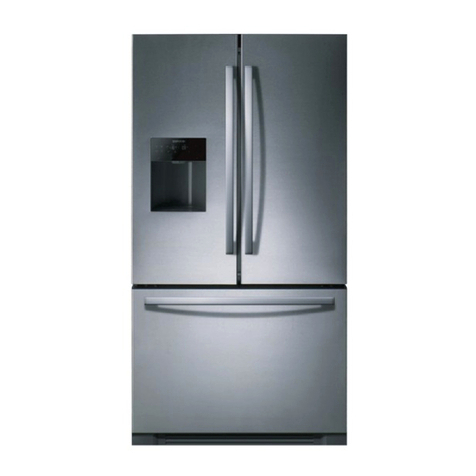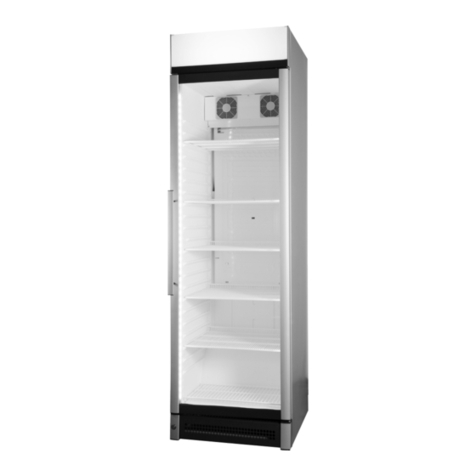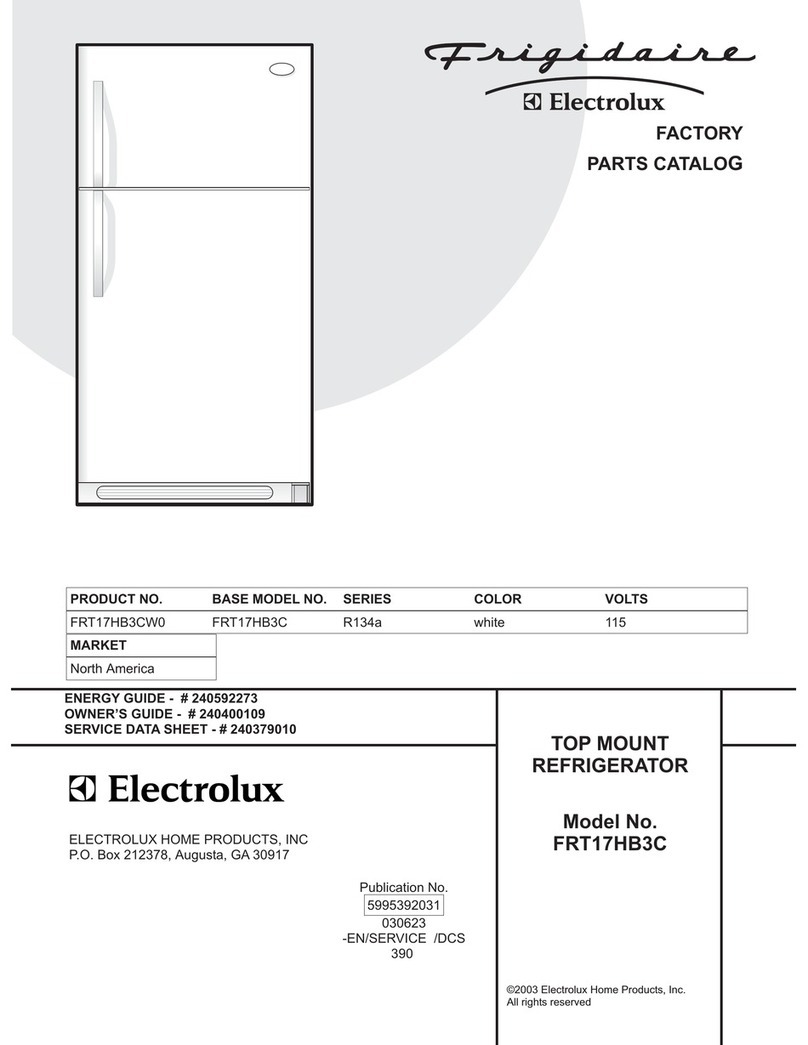KoolMore KM-CDA-18C-SS User manual

USER MANUAL
REFRIGERATOR
For any service-related Issues, please contact
us: Phone Number: 718-576-6342
Commercial Opened Air
Merchandiser Refrigerator
Model:
KM-CDA-18C-SS

Structure and Parts
Introduction
The 18 cu. ft Stainless Steel Open Air Merchandiser Refrigerator is an innovative chilling cabinet that marks
the latest development in refrigeration technology. It combines both domestic and foreign advanced
technologies based on standard food cabinet criteria, ensuring top-tier performance and reliability.
Key parts and components are supplied by leading brands, ensuring the highest standards of quality and
dependability. The product is designed with careful attention to real market demands, featuring a streamlined
design that adheres to ergonomics, allowing for easy and intuitive use.
Product Application
This refrigerator series is primarily designed for display and sale of various items such as drinks, dairy
products, vegetables, and fruits. It provides an open, easily-accessible storage solution that keeps your
products fresh and readily visible to customers. Perfect for use in retail environments such as grocery stores,
convenience stores, cafes, and more.
Please refer to the other sections of this manual for detailed instructions on assembly, installation, use,
maintenance, troubleshooting, and warranty information. Your understanding and proper operation of this
product will ensure its optimal performance and long-term service.
General
Contents
General .....................................................................................................................
Structure and Parts ................................................................................................
Assembly and Care Instructions ...........................................................................
Preparation and Power Supply ..............................................................................
Usage and Precautions ..........................................................................................
Digital Controller Troubleshooting.........................................................................
Refrigerator Troubleshooting .................................................................................
Maintenance Tips....................................................................................................
Principle of Refrigeration System and Electric Circuit Diagram ..........................
Circuit Diagram. .....................................................................................................
Major Parameters ...................................................................................................
Warranty...................................................................................................................
1.
1.
2.
3.
4.
5.
5.
6.
7.
7.
8.
9.
1

Handle with Care
Ensure to unplug the refrigerator from the
wall socket prior to moving.
Never tilt the refrigerator beyond a 45-degree
angle while handling.
Dry Location
Always position the refrigerator in a dry
location.
Ensure Sufficient Space
Maintain at least a 4-inch distance between
the refrigerator's sides and back, and any
walls or objects. This distance is crucial for
proper air circulation. Insufficient space can
impair the refrigerator's cooling ability.
Proper Ventilation
Place the refrigerator in a well-ventilated
location. After relocating the refrigerator,
allow it to stand unplugged for 2 hours
before plugging it back into the wall socket
for initial startup.
4-Inch
Avoid Heat Sources
Position the refrigerator away from direct
sunlight and other heat sources like heaters.
Exposure to such conditions can negatively
impact the refrigerator's cooling efficiency.
Avoid Heavy Loads
Do not place heavy objects atop the
refrigerator.
No Modifications
Refrain from making any alterations, such as
drilling holes or installing additional items, to
the refrigerator.
Stable Placement
Carefully unpack the refrigerator and
position it on a flat, stable surface. This
precautionary measure will help prevent
unwanted noise and vibrations.
Assembly and Care Instructions
2

No Spraying
Spraying of flammable substances such as
paint or coatings near the refrigerator is
prohibited, as it could lead to a fire
Dedicated Power Socket
The refrigerator should be powered by a
110-120V, 60Hz single-phase AC supply
through a dedicated single-phase three-pin
receptacle.
Avoid Socket Sharing
The refrigerator should never share a
common socket with other appliances to
prevent overheating of the power cable,
which could lead to a fire.
Protect Cables
Ensure the power cables are not damaged or
compromised to prevent electrical leakage
and potential fire hazards.
Avoid Water Exposure
Do not expose the refrigerator surface to
water to avoid electrical leakage.
Avoid Flammables and Explosives
Never store any flammable or explosive
substances such as ether, gasoline, alcohol,
adhesive, and explosives in the refrigerator.
Avoid placing these dangerous substances
near the refrigerator.
After Power Interruption
Following a power interruption or after
unplugging the refrigerator, wait at least 5
minutes before plugging in and restarting the
refrigerator.
Avoid Storing Medication
Do not store medication inside the refrigerator.
Preparation and Power Supply
3

Usage and Precautions
1. Initial Use
• Plug the refrigerator into an exclusive 110-120V~ socket.
• After the refrigerator is running, check the air suction for sufficient coldness. If it's
sufficiently cold, you may put food inside the cold box.
• This appliance is not intended for use by individuals (including children) with reduced
physical, sensory, or mental capabilities, or lack of experience and knowledge, unless they
have been given supervision or instruction concerning use of the appliance by a person
responsible for their safety. Ensure children do not play with the appliance unsupervised.
1. Digital Temperature Controller
A. Features:
The controller is mini-sized and intelligent, suitable for one Hp compressors. Its functions
include: Temperature Display/Control, Manual and Automatic Defrost, Illumination Control,
Value Storing, Self-Testing, and Parameter Locking.
B. Front Panel Operations:
01. Temperature Setting:
Press the “ ” button to display the set temperature. Use “ ” or “ ” buttons to
adjust and store the temperature. Press “ ” again to exit and display the cold-room
temperature.
02. Display Default:
If no button is pressed within 10 seconds, the cold-room temperature will be automati-
cally displayed.
03. Lighting and Defrost Control:
Press “ ” button to control the light; hold it for 6 seconds to start or stop the defrost
cycle.
04. Refrigerant LED:
The LED is on during refrigeration and flashes when the cold room temperature is
stable.
05. Defrost LED:
The LED is on during defrosting and turns off when defrosting ends.
06. Digital Controller Reset:
If the display shows "Disorder", press “ ” for 2 seconds until the buzzer rings.
Quickly press “ ” for 6 seconds until the buzzer rings again. The display will flash
for 3 seconds and the controller will reset to factory settings.
4

Digital Controller Troubleshooting
Open circuit or short circuit
of temperature probe
▪Check if the plug on the mainboard is loose. If so,
Secure it or replace the temperature probe if necessary.
▪Check if the plug on the mainboard is loose. If so,
Secure it or replace the defrosting probe if necessary.
1. Condenser may have too much dust - Clean the condenser.
2. Condenser motor might have stopped working - Repair or
replace the motor.
3. The unit might be too close to the wall - Maintain at least
50cm of space between the product and the wall.
4. Ambient temperature could be too high - Ensure the ambient
temperature stays within the range specified on the rating label.
SolutionCauseFaul Code
EE1
Open circuit or short circuit
of defrosting probe
EE2
▪Check if the plug on the mainboard is loose. If so,
Secure it or replace the overheating probe if necessary.
Open circuit or short circuit
of the overheating probe
Overheating probe initiates
protective program 136.4°F
EE3
EE4
Power off the unit and repair the fan blade.
1. Switch on the unit.
2. Wait for the defrosting process to complete.
3. Repair the leak and refill refrigerant.
4. Contact a professional service agent.
Fan blade may be broken.
1. Unit is switched off.
2. Defrosting process is ongoing.
3. Refrigerant is leaking.
4. Unit malfunction.
1. Increase defrosting frequency.
2. Replace the internal fan.
3. Adjust the temperature controller's set point.
4. Remove storage blocking the vent.
1. Frost blocking the evaporator.
2. Damaged internal fan.
3. Set point of temperature controller is too low.
4. Storage is blocking the vent.
1. Refill the refrigerant.
2. Adjust the temperature controller's set point.
3. Remove the source of external airflow.
4. Improve ambient conditions.
1. Insufficient refrigerant.
2. Set point of temperature controller is too high.
3. External airflow disturbing the air curtain.
4. Ambient temperature or humidity is too high.
1. Replace the heating pipe.
2. Replace the water-level controller.
3. Improve ambient conditions.
1. Damaged heating pipe for defrost water.
2. Water-level controller malfunction.
3. Ambient temperature or humidity is too high.
1. Clean the condenser.
2. Improve ventilation around the unit.
3. Replace the compressor heat protection.
4. Replace the dryer filter.
5. Replace the temperature controller.
1. Contaminated condenser.
2. Poor ventilation around the unit.
3. Failed compressor heat protection.
4. Ice blocking the capillary.
5. Faulty temperature controller.
Causes SolutionsIssues#
1
Fridge is Not Cooling
2
Weak Airflow
and Fridge Too Warm
3
Normal Airflow
but Fridge Too Warm
4
Overflowing Defrost Water
5
Temperature Inside Fridge
Keeps Changing
6
Noise from Bottom Shelf
Refrigerator Troubleshooting
Note
Certain phenomena are normal and should not be considered as faults with your refrigerator:
▪A murmuring or gurgling sound may be heard when the refrigerator is running. This is normal as
it's simply the coolant circulating within the system.
▪In humid weather, condensation may form on the exterior of the refrigerator. This is also normal
and not a cause for concern. It occurs due to high humidity levels. Simply wipe it off with a cloth.
5

Maintenance Tips
1. Cabinet Cleaning
Clean the product weekly with the power supply disconnected. Use mild water or non-corrosive
cleaner. Avoid washing directly with a water faucet.
2. Condenser Cleaning
For optimal performance, clean the condenser every month. If "EE4" message appears on the
display, clean the condenser immediately. If "EE4" appears again after cleaning, please contact
your service provider. To clean, turn off the power, loosen the screws on both sides, remove the
front panel, and clear the dust on the condenser fin using a wire brush or high-pressure air gun.
3. De-dusting the Condenser
Clean the condenser every three months with the power supply disconnected. Remove the
bottom panel for air suction and eliminate dust on the cooling fin of the condenser with a wire
brush or high-pressure air gun.
4. Leakage Check
Regularly check all connectors and welding joints for oil stains. If you spot any, implement
patching measures or call a professional for help.
5. General Observation
Regularly observe the operation of the product. If you notice abnormal noise, smell, or smoke,
disconnect the power supply immediately and call a professional. Do not restart the product
before the issue is resolved.
6. Condensation Water Drainage
Please ensure the water pipe is unobstructed, and its position is lower than the joint connected
to the upper water receiver. This setup allows for efficient and uninterrupted drainage, which is
crucial for maintaining optimal performance and longevity of your unit.
If you notice any blockage or issues with the drainage, we recommend calling a professional to
address the problem.
Please note:
We will not be responsible for any accidents incurred by failure to follow these guidelines.
6

Principle of Refrigeration System and Electric Circuit Diagram
Circuit Diagram
The principle of the compression refrigeration system revolves around four main steps:
"compression," "condensation," "throttling," and "vaporization."
The process operates as follows:
▪Compression:The compressor takes in the coolant, which has absorbed heat in the evaporator,
turning it into a high-pressure, high-temperature gas.
▪Condensation: In the condenser, the coolant dissipates heat into the air. As a result, the coolant
re-liquefies.
▪Throttling: This phase is executed by the capillary, which throttles the re-liquefied coolant into
the evaporator at a low pressure.
▪Vaporization: Upon entering the evaporator, the liquefied coolant quickly boils and vaporizes into
a gas due to the sudden drop in pressure. In this phase, it absorbs heat from inside the refrigerator.
Finally, the compressor again takes in the low-pressure, low-temperature gaseous coolant.
The process repeats itself in a cycle, enabling the refrigerator to maintain its cool temperature.
7

Major Parameters
Note
▪In the event of any changes, the final electric circuit diagram and parameters will be those
specified on the product nameplate.
▪Our design may be improved without prior notice to continuously enhance product performance
and user experience.
▪If the supply cord is damaged, it must be replaced immediately by the manufacturer, its service
agent, or a similarly qualified professional to avoid potential hazards.
WARNING
This refrigerator utilizes R290, a flammable refrigerant. Please exercise utmost caution
to prevent fire risks. The enclosed warning symbol triangle is at least 0.59 inches in
height to emphasize the importance of this safety information.
Disposal Instructions
The crossed-out wheeled dustbin symbol indicates that electrical appliances should not
be disposed of as unsorted municipal waste. Instead, utilize separate collection facilities.
For information regarding the available collection systems, contact your local govern-
ment. If electrical appliances are improperly disposed of in landfills or dumps, hazard-
ous substances can leak into the groundwater and enter the food chain, posing risks to
health and well-being.
When replacing old appliances with new ones, check with your retailer about any haul-away or
recycling programs they may offer for your old appliance. Remember to also check local regulations
and available recycling programs in your area to ensure proper disposal.
Model
Coolant and injection quantity (g)
Rated Input Power (W)
Type of Climate
Refrigeration Temperature (°F)
Max.ambienttemp./RH
Total effective volume (Cu.Ft.)
Net weight (LB)
Rated voltage (V)
Rated Current (A)
Rated Frequency (Hz)
Overall dimension (IN) (LxWxH)
Blowing Gas
KM-CDA-18C-SS
R290 & 490
1320
3
°35.6 - °50
°77 (°F) / 60%
19.7
289.9
110-120~
14
60
35.2” x 20” x 79.9”
C5H10
8

LIMITED WARRANTY
1.Failure of product to perform during power failures and interruptions or inadequate electrical service
2.Damage caused by transportation or handling.
3.Damage caused to the product by accident, vermin, lightnin winds, fire, floods, or acts of God.
4.Damage resulting from accident, alteration, misuse, abuse, or improper installation, repair, or
maintenance. Improper use includes using an external device that alters or converts the voltage or
frequency of electricity
5.Any unauthorized product modification, repair by unauthorized repair center, or use of non-approved
replacement parts.
6.Abnormal cleaning and maintenance as described in the user's manual.
7.Use of accessories or components that are not compatible with this product.
The cost of repair or replacement under these excluded circumstances shall be borne by the consumer.
LIMITED WARRANTY KOOLMORE SUPPLY, INC. warrants to the original consumer or purchaser this
KOOLMORE product is free from defects in material or workmanship for a period of One (1) year from
the date of purchase. If any such defect is discovered within the warranty period,
KOOLMORE SUPPLY, INC., at its discretion, will repair or replace the product at no cost or pay for
replacement parts and repair labor to correct defects in materials or workmanship that existed when this
major appliance was purchased or that are the result of normal usage when this major appliance is
installed, operated and maintained according to instructions attached to or furnished with the product, At
its sole discretion. Koolmore Supply Inc may determine to replace the product. In the event of product
replacement, your appliance will be warranted for the remaining term of the original unit's warranty
period.
This limited warranty is good only to the original purchaser of the product and effective only when used
in the United States.
This limited warranty is effective from the date of original consumer purchase. Proof of original purchase
date is required to obtain service under this limited warranty.
YOU’RE SOLE AND EXCLUSIVE REMEDY UNDER THIS LIMITED WARRANTY SHALL BE
PRODUCT REPAIR AS PROVIDED HEREIN.
Service must be provided by a Koolmore designated service company.
number, warranty repair request, and a copy of your proof of purchase receipt.
You can also visit us at koolmore.com and use the contact us page.
KOOLMORE customer service will contact you and arrange prompt service for your appliance.
Thank you for choosing KOOLMORE.
THIS LIMITED WARRANTY DOES NOT APPLY TO
WARRANTY
9

Table of contents
Other KoolMore Refrigerator manuals
